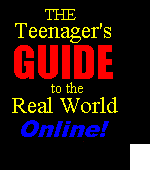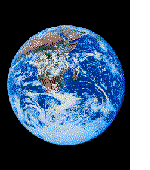  |

This is an online resource for the book The Teenager's Guide to the Real World by Marshall Brain, ISBN 1-9657430-3-9. The online resources are offered as a free supplement to the book. They help you access the huge library of material for teenager's available on the Web. For more information on the book please click here.
Creating Your Own Web Page as a Teenager
If you want to create your own page, you have two choices. You can create a page that says, "Hi, My name is Suzy and here is a picture of Binky my cat and my favorite coolest bands are..." That is fine, but it is not of much interest to anyone but your immediate friends. The other choice you have is to create a site that other people find useful. Pick something you enjoy or know a lot about and create a page about it. For example:
- If you know a lot about repairing lawnmower engines, create a page on repairing lawnmower engines
- If you know a lot about quilts, create a page on quilting
- If you like chemistry, create a page with a thousand chemistry links
- If you like football, create the best page on the net about football
- If you like clothes, create a superb fashion page
The first step to creating your own page is finding a place for your page to live. If you are a member of some of the larger Internet services like AOL, they may give you space for your own page for free. If so, use that space. If you are a college student your college may offer space free to students. If not, try a place like Geocities.
Next you will need to learn how to create your own pages. You can either use a tool that helps you create a page, or you can create a page by coding HTML yourself (it's easy). Tools can range anywhere from the Microsoft Internet Assistant (which is free and works with Microsoft Word (see the Microsoft site for information)) to a variety of free tools (see this). If you want to code your own pages by hand (and learn a valuable skill in the process) then see How a Web Page Works.
You can actually play with web page creation on your own, even if you do not have a connection to the web. You will be the only one who can see the pages you create, but it is a great way to experiment and learn HTML. What you do is create the page as a file on your local hard drive, and then open the page as a file with a web browser. Netscape has an "Open File..." option and MS Explorer has an "Open..." option that let you open local files. It is a great way to experiment. You can create your page, tune it, and then when it is all ready and perfect put it out on a public web site. If you want a super-simple way to get started, look at this. Using the techniques described there you can create super-simple pages. Then you can look at the tags in other pages that you see on the web (use the "Source" or "View Document Source" option in your browser) and you can "see" how people create any page.
Have fun!
Return to the Home Page for The Teenager's Guide to the Real World

BYG Publishing, Inc.
http://www.bygpub.com - info@bygpub.com
(888)294-7820 - P.O. Box 40492 - Raleigh, NC 27629
Questions or comments, email:
questions@bygpub.com
© 1997 BYG Publishing, Inc. All rights reserved.